brakes PEUGEOT 308 2011 Owners Manual
[x] Cancel search | Manufacturer: PEUGEOT, Model Year: 2011, Model line: 308, Model: PEUGEOT 308 2011Pages: 328, PDF Size: 62.67 MB
Page 127 of 328
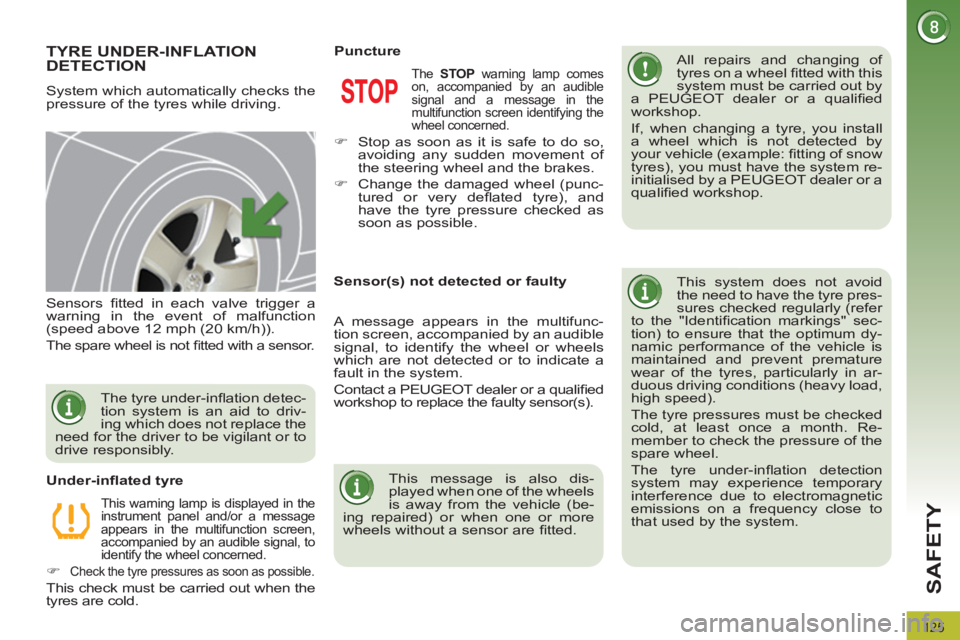
125
SAFETY
TYRE UNDER-INFLATION
DETECTION
System which automatically checks the
pressure of the tyres while driving.
All repairs and changing of
tyres on a wheel fi tted with this
system must be carried out by
a PEUGEOT dealer or a qualifi ed
workshop.
If, when changing a tyre, you install
a wheel which is not detected by
your vehicle (example: fi tting of snow
tyres), you must have the system re-
initialised by a PEUGEOT dealer or a
qualifi ed workshop.
This system does not avoid
the need to have the tyre pres-
sures checked regularly (refer
to the "Identifi cation markings" sec-
tion) to ensure that the optimum dy-
namic performance of the vehicle is
maintained and prevent premature
wear of the tyres, particularly in ar-
duous driving conditions (heavy load,
high speed).
The tyre pressures must be checked
cold, at least once a month. Re-
member to check the pressure of the
spare wheel.
The tyre under-infl ation detection
system may experience temporary
interference due to electromagnetic
emissions on a frequency close to
that used by the system.
Sensors fi tted in each valve trigger a
warning in the event of malfunction
(speed above 12 mph (20 km/h)).
The spare wheel is not fi tted with a sensor.
This warning lamp is displayed in the
instrument panel and/or a message
appears in the multifunction screen,
accompanied by an audible signal, to
identify the wheel concerned.
�)
Check the tyre pressures as soon as possible.
This check must be carried out when the
tyres are cold.
Under-infl ated tyre
The STOP
warning lamp comes
on, accompanied by an audible
signal and a message in the
multifunction screen identifying the
wheel concerned.
�)
Stop as soon as it is safe to do so,
avoiding any sudden movement of
the steering wheel and the brakes.
�)
Change the damaged wheel (punc-
tured or very defl ated tyre), and
have the tyre pressure checked as
soon as possible.
Puncture
The tyre under-infl ation detec-
tion system is an aid to driv-
ing which does not replace the
need for the driver to be vigilant or to
drive responsibly.
Sensor(s) not detected or faulty
A message appears in the multifunc-
tion screen, accompanied by an audible
signal, to identify the wheel or wheels
which are not detected or to indicate a
fault in the system.
Contact a PEUGEOT dealer or a qualifi ed
workshop to replace the faulty sensor(s).
This message is also dis-
played when one of the wheels
is away from the vehicle (be-
ing repaired) or when one or more
wheels without a sensor are fi tted.
Page 128 of 328
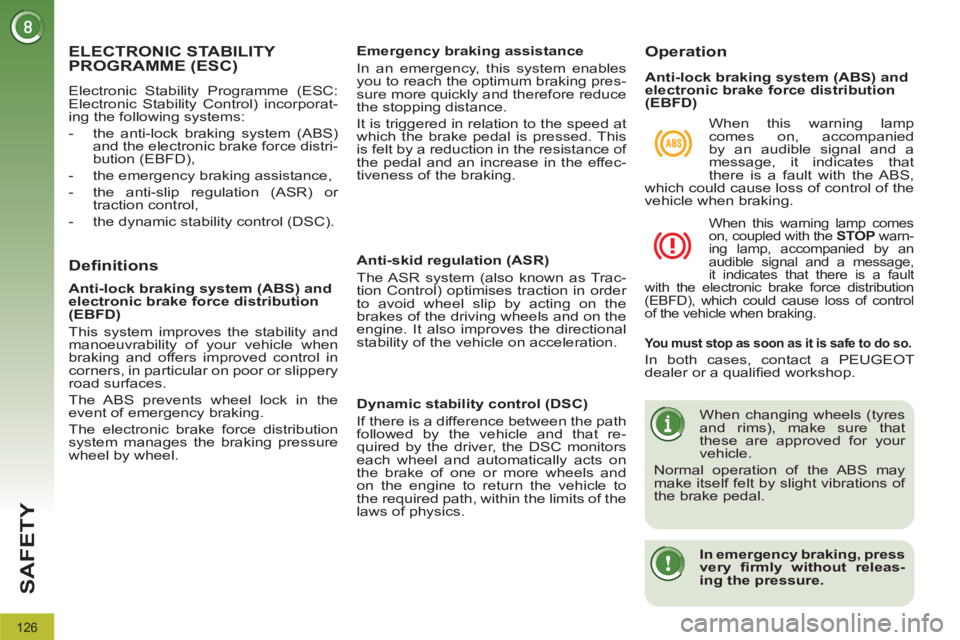
126
SAFETY
ELECTRONIC STABILITY
PROGRAMME (ESC)
Electronic Stability Programme (ESC:
Electronic Stability Control) incorporat-
ing the following systems:
- the anti-lock braking system (ABS)
and the electronic brake force distri-
bution (EBFD),
- the emergency braking assistance,
- the anti-slip regulation (ASR) or
traction control,
- the dynamic stability control (DSC).
Definitions
Anti-skid regulation (ASR)
The ASR system (also known as Trac-
tion Control) optimises traction in order
to avoid wheel slip by acting on the
brakes of the driving wheels and on the
engine. It also improves the directional
stability of the vehicle on acceleration.
Dynamic stability control (DSC)
If there is a difference between the path
followed by the vehicle and that re-
quired by the driver, the DSC monitors
each wheel and automatically acts on
the brake of one or more wheels and
on the engine to return the vehicle to
the required path, within the limits of the
laws of physics.
Emergency braking assistance
In an emergency, this system enables
you to reach the optimum braking pres-
sure more quickly and therefore reduce
the stopping distance.
It is triggered in relation to the speed at
which the brake pedal is pressed. This
is felt by a reduction in the resistance of
the pedal and an increase in the effec-
tiveness of the braking.
Anti-lock braking system (ABS) and
electronic brake force distribution
(EBFD)
This system improves the stability and
manoeuvrability of your vehicle when
braking and offers improved control in
corners, in particular on poor or slippery
road surfaces.
The ABS prevents wheel lock in the
event of emergency braking.
The electronic brake force distribution
system manages the braking pressure
wheel by wheel.
Operation
When this warning lamp
comes on, accompanied
by an audible signal and a
message, it indicates that
there is a fault with the ABS,
which could cause loss of control of the
vehicle when braking.
When this warning lamp comes
on, coupled with the STOP
warn-
ing lamp, accompanied by an
audible signal and a message,
it indicates that there is a fault
with the electronic brake force distribution
(EBFD), which could cause loss of control
of the vehicle when braking.
You must stop as soon as it is safe to do so.
In both cases, contact a PEUGEOT
dealer or a qualifi ed workshop.
When changing wheels (tyres
and rims), make sure that
these are approved for your
vehicle.
Normal operation of the ABS may
make itself felt by slight vibrations of
the brake pedal.
In emergency braking, press
very fi rmly without releas-
ing the pressure.
Anti-lock braking system (ABS) and
electronic brake force distribution
(EBFD)
Page 157 of 328
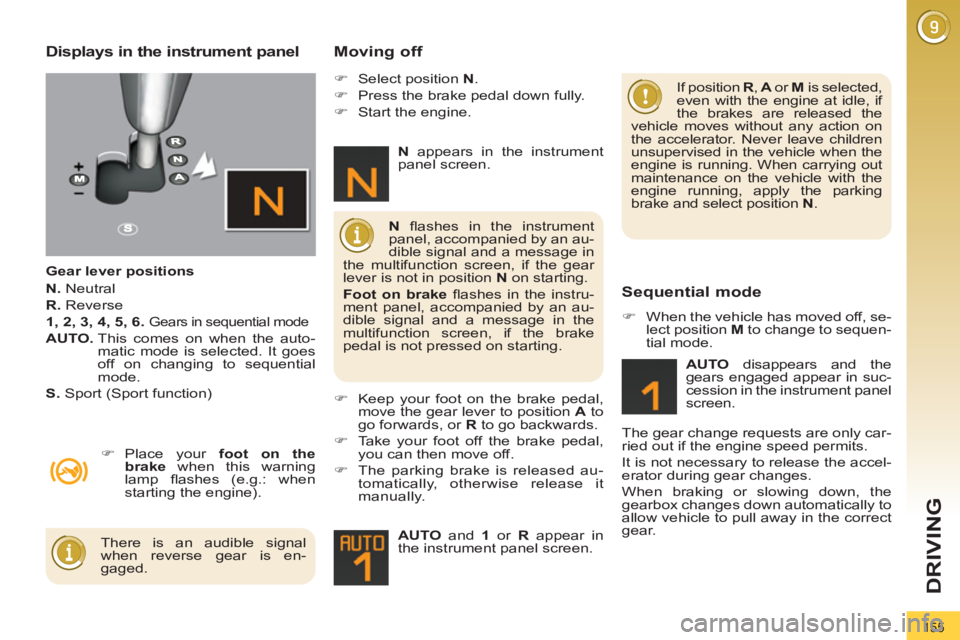
155
DRIVING
Displays in the instrument panel
Gear lever positions
N.
Neutral
R.
Reverse
1, 2, 3, 4, 5, 6.
Gears in sequential mode
AUTO.
This comes on when the auto-
matic mode is selected. It goes
off on changing to sequential
mode.
S.
Sport (Sport function)
Moving off
�)
Place your foot on the
brake
when this warning
lamp fl ashes (e.g.: when
starting the engine).
�)
Select position N
.
�)
Press the brake pedal down fully.
�)
Start the engine.
�)
Keep your foot on the brake pedal,
move the gear lever to position A
to
go forwards, or R
to go backwards.
�)
Take your foot off the brake pedal,
you can then move off.
�)
The parking brake is released au-
tomatically, otherwise release it
manually.
AUTO
and 1
or R
appear in
the instrument panel screen.
N
fl ashes in the instrument
panel, accompanied by an au-
dible signal and a message in
the multifunction screen, if the gear
lever is not in position N
on starting.
Foot on brake
fl ashes in the instru-
ment panel, accompanied by an au-
dible signal and a message in the
multifunction screen, if the brake
pedal is not pressed on starting.
There is an audible signal
when reverse gear is en-
gaged.
N
appears in the instrument
panel screen.
Sequential mode
�)
When the vehicle has moved off, se-
lect position M
to change to sequen-
tial mode.
AUTO
disappears and the
gears engaged appear in suc-
cession in the instrument panel
screen.
The gear change requests are only car-
ried out if the engine speed permits.
It is not necessary to release the accel-
erator during gear changes.
When braking or slowing down, the
gearbox changes down automatically to
allow vehicle to pull away in the correct
gear. If position R
, A
or M
is selected,
even with the engine at idle, if
the brakes are released the
vehicle moves without any action on
the accelerator. Never leave children
unsupervised in the vehicle when the
engine is running. When carrying out
maintenance on the vehicle with the
engine running, apply the parking
brake and select position N
.
Page 161 of 328
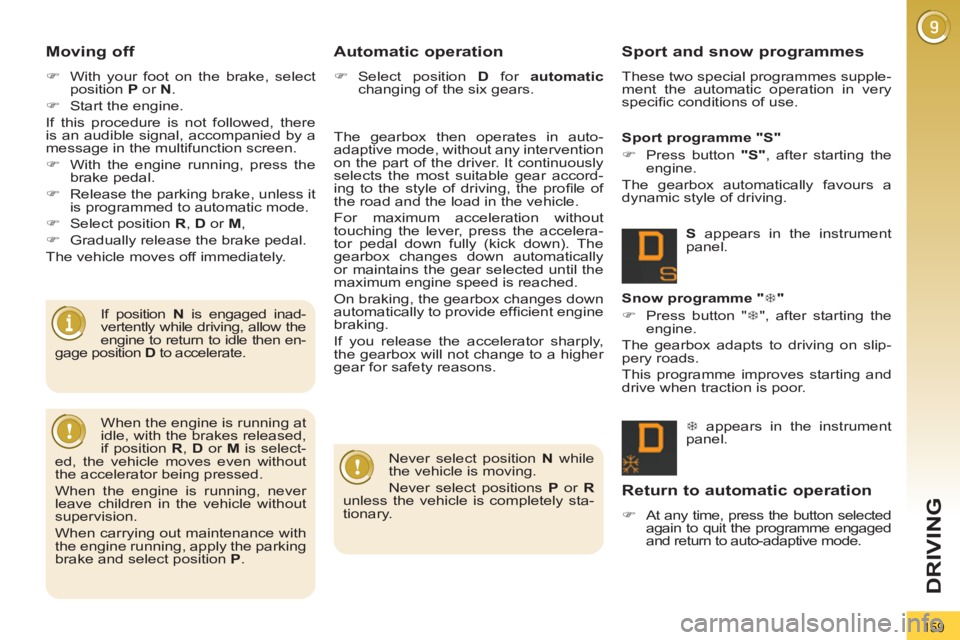
159
DRIVING
Moving off
�)
With your foot on the brake, select
position P
or N
.
�)
Start the engine.
If this procedure is not followed, there
is an audible signal, accompanied by a
message in the multifunction screen.
�)
With the engine running, press the
brake pedal.
�)
Release the parking brake, unless it
is programmed to automatic mode.
�)
Select position R
, D
or M
,
�)
Gradually release the brake pedal.
The vehicle moves off immediately.
If position N
is engaged inad-
vertently while driving, allow the
engine to return to idle then en-
gage position D
to accelerate. The gearbox then operates in auto-
adaptive mode, without any intervention
on the part of the driver. It continuously
selects the most suitable gear accord-
ing to the style of driving, the profi le of
the road and the load in the vehicle.
For maximum acceleration without
touching the lever, press the accelera-
tor pedal down fully (kick down). The
gearbox changes down automatically
or maintains the gear selected until the
maximum engine speed is reached.
On braking, the gearbox changes down
automatically to provide effi cient engine
braking.
If you release the accelerator sharply,
the gearbox will not change to a higher
gear for safety reasons.
Automatic operation
�)
Select position D
for automatic
changing of the six gears.
�7
appears in the instrument
panel.
Snow programme " �7
"
�)
Press button " �7
", after starting the
engine.
The gearbox adapts to driving on slip-
pery roads.
This programme improves starting and
drive when traction is poor.
S
appears in the instrument
panel.
Sport programme "S"
�)
Press button "S"
, after starting the
engine.
The gearbox automatically favours a
dynamic style of driving.
Never select position N
while
the vehicle is moving.
Never select positions P
or R
unless the vehicle is completely sta-
tionary.
When the engine is running at
idle, with the brakes released,
if position R
, D
or M
is select-
ed, the vehicle moves even without
the accelerator being pressed.
When the engine is running, never
leave children in the vehicle without
supervision.
When carrying out maintenance with
the engine running, apply the parking
brake and select position P
.
Sport and snow programmes
These two special programmes supple-
ment the automatic operation in very
specifi c conditions of use.
Return to automatic operation
�)
At any time, press the button selected
again to quit the programme engaged
and return to auto-adaptive mode.
Page 175 of 328
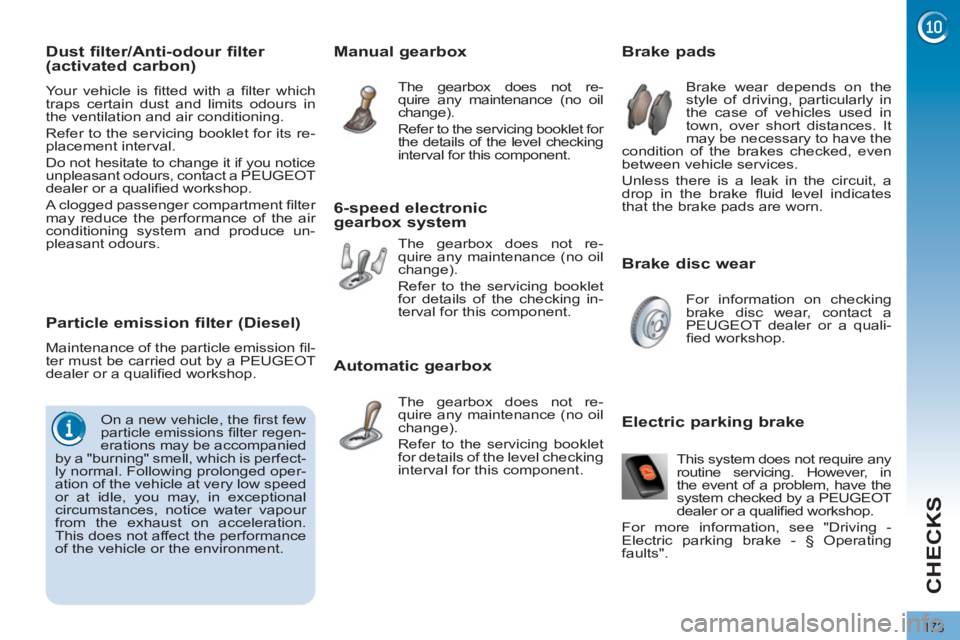
173
CHECKS
Brake disc wear
Brake pads
Brake wear depends on the
style of driving, particularly in
the case of vehicles used in
town, over short distances. It
may be necessary to have the
condition of the brakes checked, even
between vehicle services.
Unless there is a leak in the circuit, a
drop in the brake fl uid level indicates
that the brake pads are worn.
For information on checking
brake disc wear, contact a
PEUGEOT dealer or a quali-
fi ed workshop.
Manual gearbox
The gearbox does not re-
quire any maintenance (no oil
change).
Refer to the servicing booklet for
the details of the level checking
interval for this component.
6-speed electronic
gearbox system
The gearbox does not re-
quire any maintenance (no oil
change).
Refer to the servicing booklet
for details of the checking in-
terval for this component.
Automatic gearbox
The gearbox does not re-
quire any maintenance (no oil
change).
Refer to the servicing booklet
for details of the level checking
interval for this component. This system does not require any
routine servicing. However, in
the event of a problem, have the
system checked by a PEUGEOT
dealer or a qualifi ed workshop.
For more information, see "Driving -
Electric parking brake - § Operating
faults".
Electric parking brake
Particle emission filter (Diesel)
Maintenance of the particle emission fi l-
ter must be carried out by a PEUGEOT
dealer or a qualifi ed workshop.
On a new vehicle, the fi rst few
particle emissions fi lter regen-
erations may be accompanied
by a "burning" smell, which is perfect-
ly normal. Following prolonged oper-
ation of the vehicle at very low speed
or at idle, you may, in exceptional
circumstances, notice water vapour
from the exhaust on acceleration.
This does not affect the performance
of the vehicle or the environment.
Dust filter/Anti-odour filter
(activated carbon)
Your vehicle is fi tted with a fi lter which
traps certain dust and limits odours in
the ventilation and air conditioning.
Refer to the servicing booklet for its re-
placement interval.
Do not hesitate to change it if you notice
unpleasant odours, contact a PEUGEOT
dealer or a qualifi ed workshop.
A clogged passenger compartment fi lter
may reduce the performance of the air
conditioning system and produce un-
pleasant odours.
Page 204 of 328
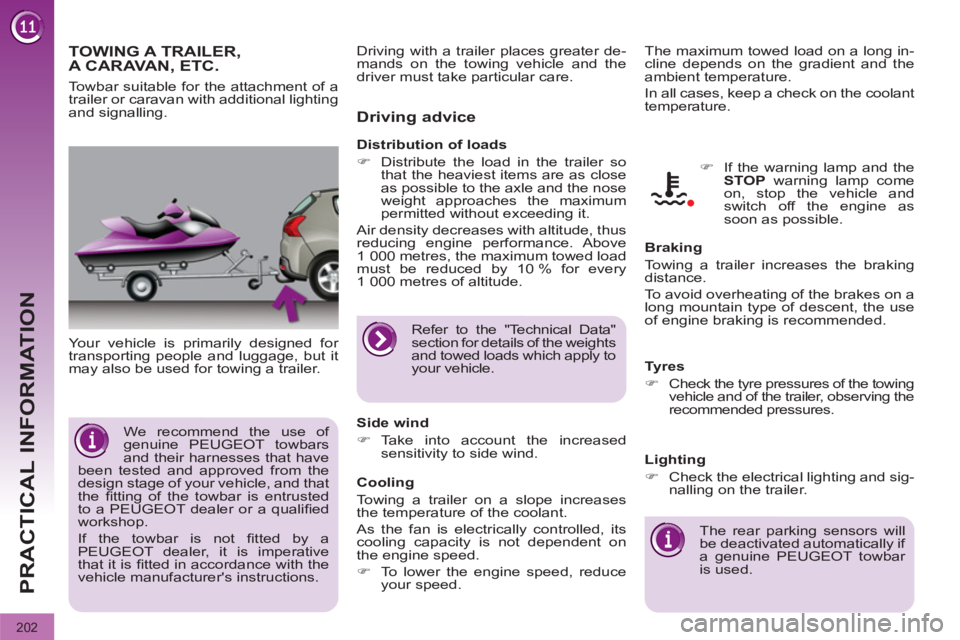
202
PRACTICAL INFORMATION
TOWING A TRAILER,
A CARAVAN, ETC.
Your vehicle is primarily designed for
transporting people and luggage, but it
may also be used for towing a trailer.
Driving advice
The maximum towed load on a long in-
cline depends on the gradient and the
ambient temperature.
In all cases, keep a check on the coolant
temperature.
Side wind
�)
Take into account the increased
sensitivity to side wind.
Cooling
Towing a trailer on a slope increases
the temperature of the coolant.
As the fan is electrically controlled, its
cooling capacity is not dependent on
the engine speed.
�)
To lower the engine speed, reduce
your speed.
Braking
Towing a trailer increases the braking
distance.
To avoid overheating of the brakes on a
long mountain type of descent, the use
of engine braking is recommended.
Tyres
�)
Check the tyre pressures of the towing
vehicle and of the trailer, observing the
recommended pressures.
Lighting
�)
Check the electrical lighting and sig-
nalling on the trailer.
The rear parking sensors will
be deactivated automatically if
a genuine PEUGEOT towbar
is used.
�)
If the warning lamp and the
STOP
warning lamp come
on, stop the vehicle and
switch off the engine as
soon as possible.
Towbar suitable for the attachment of a
trailer or caravan with additional lighting
and signalling.
Distribution of loads
�)
Distribute the load in the trailer so
that the heaviest items are as close
as possible to the axle and the nose
weight approaches the maximum
permitted without exceeding it.
Air density decreases with altitude, thus
reducing engine performance. Above
1 000 metres, the maximum towed load
must be reduced by 10 % for every
1 000 metres of altitude. Driving with a trailer places greater de-
mands on the towing vehicle and the
driver must take particular care.
We recommend the use of
genuine PEUGEOT towbars
and their harnesses that have
been tested and approved from the
design stage of your vehicle, and that
the fi tting of the towbar is entrusted
to a PEUGEOT dealer or a qualifi ed
workshop.
If the towbar is not fi tted by a
PEUGEOT dealer, it is imperative
that it is fi tted in accordance with the
vehicle manufacturer's instructions. Refer to the "Technical Data"
section for details of the weights
and towed loads which apply to
your vehicle.
Page 317 of 328

A
CB
D
315
ALPHABETICAL INDEX
Accessories ................................204
Accessory socket,
12 V ........................ 100, 102, 109
Adjusting headlamps ..............92, 93
Adjusting head restraints ..............67
Adjusting seat
belt height ........................130, 131
Adjusting the steering
wheel .........................................73
Airbags .........................................36
Airbags, curtain...................135, 136
Airbags, front ......................133, 136
Airbags, lateral....................135, 136
Air conditioning .............................25
Air conditioning, digital............59, 62
Air conditioning,
manual .................................59, 60
Air fi lter .......................................172
Air fl ow ..........................................25
Air vents........................................58
Alarm ............................................79
Anti-pinch..............................81, 106
Anti-theft .......................................76
Armrest .......................................100
Armrest, front ..............................102
Armrest, rear ...............................105
Assistance call ............................214
Audible warning ..........................124
Audio/video sockets....................244
Audio streaming (Bluetooth) .......305
Automatic illumination
of headlamps .......................89, 92
Automatic operation of hazard
warning lamps .........................124
Automatic rain sensitive
windscreen wipers ...............94, 96
Auxiliary
socket ............. 244, 280, 300, 302Capacity, fuel tank ........................87
CD MP3 ..............................279, 299
Central locking ........................75, 84
Changing a bulb ........ 185, 188, 189
Changing a fuse .........................190
Changing a wheel ...............180, 182
Changing a wiper blade ........96, 200
Changing the date ..... 250, 284, 307
Changing the remote
control battery ............................77
Changing the time ..... 250, 284, 307
Checking levels ..................171, 172
Checking the engine oil level ........40
Checking tyre pressures
(using the kit) ...........................174
Checks............... 169, 170, 172, 173
Child lock ....................................123
Children ...................... 118, 121, 122Child seats ................................. 113
Child seats,
conventional .................... 116, 118
Closing the boot................75, 85, 86
Closing the doors....................75, 83
Cold climate screen ....................203
Colour screen,
retractable ......................49, 51, 53
Connectors,
audio ....... 101, 102, 280, 300, 302
Control for panoramic
sunroof blind ............................106
Coolant level .........................37, 171
Coolant temperature indicator ......37
Courtesy lamps.............................97
Courtesy mirror ...........................101
Cruise control .............................151
Cup holder ..................................100 Battery ................................172, 197
Battery, charging .........................197
Battery, remote control ...........77, 78
Blind for panoramic sunroof........106
Bluetooth (hands-
free) ......... 245-247, 281, 282, 303
Bluetooth
(telephone) ...... 245-247, 281, 282
Bonnet ........................................167
Bonnet stay.................................167
Boot fl oor, adjustable .................. 111
Boot lamp ............................. 99, 112
Boot lid..........................................86
Brake discs .................................173
Brake lamps................................188
Brake pads .................................173
Brakes ........................................173
Date (setting) ..... 250, 284, 306, 307
Daytime
running lamps ........... 91, 185, 187
Deactivating the passenger
airbag .......................................133
Deadlocking ..................................75
Defrosting ...............................60, 61
Demisting......................................60
Dials and gauges ..........................27
Diesel additive level ....................172
Dimensions .................................210
Dipped beam ............... 89, 185, 186
Dipstick .................................40, 171
Directional lighting ........................93
Direction indicators .... 124, 185, 188
Distance alert..............................147
Doors ............................................83
Doors emergency control .............85
Door trays ...................................100
Dynamic emergency braking ......140